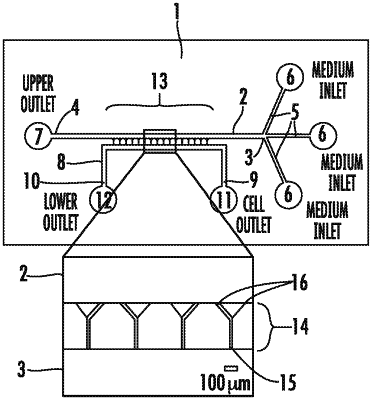| CPC G01N 33/574 (2013.01) [B01L 3/502761 (2013.01); G01N 33/5011 (2013.01); G01N 33/5029 (2013.01); G01N 33/5091 (2013.01); B01L 2200/0652 (2013.01); B01L 2300/0816 (2013.01); B01L 2300/0867 (2013.01); G01N 2800/7028 (2013.01)] | 9 Claims |

|
1. A method for identifying the invasiveness of at least one cancer cell in a sample, the method comprising:
a) obtaining the at least one cancer cell from the sample;
b) incubating the at least one cancer cell for a period time sufficient to allow the at least one cancer cell to seed at the base of a migratory channel of an integrative microfluidic apparatus;
c) imaging, by an imaging system, the at least one cancer cell in the integrative microfluidic apparatus for a period of time sufficient to allow migration of migratory cancer cells of the at least one cancer cell through the migratory channel; and
d) determining a respective cancer cell of the at least one cancer cell is invasive when the respective cancer cell migrates through the migratory channel of the integrative microfluidic apparatus, wherein the migratory channel comprises:
a body segment having sufficiently reduced dimensions so as to allow only one migratory cancer cell of the at least one cancer cell to enter into a first end of the migratory channel at a time, and
a first branch and a second branch extending from a second end of the body segment, wherein the first branch and the second branch each have respective widths, and wherein the width of the first branch is different than the width of the second branch, wherein the second end of the body segment and the first and second branches meet at the bifurcation point of the migratory channel, and wherein the respective migratory cancer cell migrates through the migratory channel by entering the first end of the migratory channel and passing through the bifurcation point of the migratory channel to enter the first branch or the second branch.
|